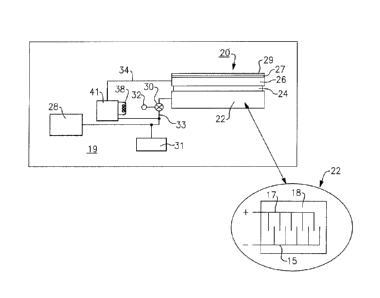Some of the information on this Web page has been provided by external sources. The Government of Canada is not responsible for the accuracy, reliability or currency of the information supplied by external sources. Users wishing to rely upon this information should consult directly with the source of the information. Content provided by external sources is not subject to official languages, privacy and accessibility requirements.
Any discrepancies in the text and image of the Claims and Abstract are due to differing posting times. Text of the Claims and Abstract are posted:
| (12) Patent Application: | (11) CA 2976403 |
|---|---|
| (54) English Title: | HEATED PTC ELEMENT WITH PROTECTION CIRCUIT |
| (54) French Title: | ELEMENT PTC CHAUFFE DOTE D'UN CIRCUIT DE PROTECTION |
| Status: | Pre-Grant |
| (51) International Patent Classification (IPC): |
|
|---|---|
| (72) Inventors : |
|
| (73) Owners : |
|
| (71) Applicants : |
|
| (74) Agent: | NORTON ROSE FULBRIGHT CANADA LLP/S.E.N.C.R.L., S.R.L. |
| (74) Associate agent: | |
| (45) Issued: | |
| (22) Filed Date: | 2017-08-11 |
| (41) Open to Public Inspection: | 2018-03-01 |
| Examination requested: | 2022-02-11 |
| Availability of licence: | N/A |
| (25) Language of filing: | English |
| Patent Cooperation Treaty (PCT): | No |
|---|
| (30) Application Priority Data: | ||||||
|---|---|---|---|---|---|---|
|
A heater electrical short protection arrangement has a heating layer that is
at least
partially electrically conductive. A conductive layer is initially
electrically insulated
from the heating layer. A circuit in electrical communication with the
conductive layer
is configured to halt a supply of electrical energy to the heating layer in
response to
current flowing into the conductive layer.
Note: Claims are shown in the official language in which they were submitted.
Note: Descriptions are shown in the official language in which they were submitted.

For a clearer understanding of the status of the application/patent presented on this page, the site Disclaimer , as well as the definitions for Patent , Administrative Status , Maintenance Fee and Payment History should be consulted.
| Title | Date |
|---|---|
| Forecasted Issue Date | 2024-06-04 |
| (22) Filed | 2017-08-11 |
| (41) Open to Public Inspection | 2018-03-01 |
| Examination Requested | 2022-02-11 |
There is no abandonment history.
Last Payment of $210.51 was received on 2023-07-21
Upcoming maintenance fee amounts
| Description | Date | Amount |
|---|---|---|
| Next Payment if small entity fee | 2024-08-12 | $100.00 |
| Next Payment if standard fee | 2024-08-12 | $277.00 |
Note : If the full payment has not been received on or before the date indicated, a further fee may be required which may be one of the following
Patent fees are adjusted on the 1st of January every year. The amounts above are the current amounts if received by December 31 of the current year.
Please refer to the CIPO
Patent Fees
web page to see all current fee amounts.
| Fee Type | Anniversary Year | Due Date | Amount Paid | Paid Date |
|---|---|---|---|---|
| Application Fee | $400.00 | 2017-08-11 | ||
| Maintenance Fee - Application - New Act | 2 | 2019-08-12 | $100.00 | 2019-07-23 |
| Maintenance Fee - Application - New Act | 3 | 2020-08-11 | $100.00 | 2020-07-21 |
| Maintenance Fee - Application - New Act | 4 | 2021-08-11 | $100.00 | 2021-07-21 |
| Request for Examination | 2022-08-11 | $814.37 | 2022-02-11 | |
| Maintenance Fee - Application - New Act | 5 | 2022-08-11 | $203.59 | 2022-07-21 |
| Maintenance Fee - Application - New Act | 6 | 2023-08-11 | $210.51 | 2023-07-21 |
| Final Fee | $416.00 | 2024-04-24 |
Note: Records showing the ownership history in alphabetical order.
| Current Owners on Record |
|---|
| HAMILTON SUNDSTRAND CORPORATION |
| Past Owners on Record |
|---|
| None |